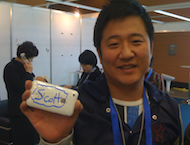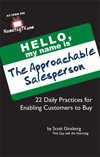 Engagement is the new marketing.
Engagement is the new marketing.
How people experience you, plus how people experience themselves in relation to you, is now what determines your success.
Straight from my column on monthly column on American Express Open Forum, here’s what smart entrepreneurs know about engaging their customers: 1. Master the power of personalization. If your customers wore nametags, would you give them better service? Sure you would. Names reduce the distance between people. Today, my flight attendant noticed my nametag and said, “Scott, I wish all my passengers wore nametags, that way I wouldn’t have to say sir!” Makes sense. With a nametag, it’s an unmasking. It assures you’re no longer just another face in the crowd. It humanizes you. And it makes it easier for people treat you with dignity, respect and compassion.
Sadly, most organizations miss this. They obsess over offering better customer service, but fail to see the big picture about the actual relationship. Truth is, the purpose of a nametag isn’t to enable customers to tattle on someone who gives poor service. The purpose of nametag is to help you become better friends with customers, that way, better service happens naturally. Familiarity doesn’t breed contempt—it brings people back.
2. Lower the threat level. I was meeting my friends for sushi once and they invited a girl named Sandra, a friend of a friend who was passing through town. When we met, she thanked me for wearing a nametag. “It’s just so non-threatening,” she said. Interesting.
How do you lower the threat level when you meet people? With most strangers, you’re starting with negative balance. You’re operating from a deficit position. It’s just the posture of the masses. People have been sold, scammed, conned, manipulated and used too long—and they’re tired of it. But a nametag takes a few bricks out of the wall. A nametag immediately and intentionally disqualifies me from people’s fears.
3. Trust is a function of self-disclosure. The more you reveal about yourself, the more likely people are to trust you. That’s a basic tenant of human communication. But you don’t need books to know how trust works. That’s what the nametag proved: Strangers trusted me more once they knew my name. Not that much more, but there was enough additional trust to be noticeable. People recognized my willingness to stick myself out there—albeit in a small, simple way—and as a result, perceived me as being a more trustworthy person.
But it was weird. I didn’t really do anything. Just wore a nametag that said, “Scott.” And yet, people would tell me things. Personal things. I’ll never forget the time I sat down next to an older guy at the train station. He noticed my nametag and said hello. I did the same. He then proceeded to tell me every single detail about his wife’s schizophrenia. And I was happy to listen, but the whole time I kept thinking to myself, “Sir, why are you telling me all this?” Simple: He felt like he already knew me.
4. Enable reciprocity. I was in a cupcake store in Australia. When the cashier rang me up, I clumsily grabbed all the coins in my pocket, took one look at the confusing shapes and colors, then took one look at the long line behind me, turned to cashier and said: “Here. You do it.” She smiled back; picked out the coins she needed and completed the transaction.
That’s reciprocity. If you want people to trust you, trust them first. Even if you have no logical reason to do so. You always gain a greater interaction. The world is a mirror. What you put out, comes back. It’s not a cliché—it’s human nature. People have mindless, automatic reciprocity reflexes. And they perform certain actions when the world presents them with certain patterns of input. That’s why strangers will spontaneously introduce themselves to me: Not necessarily because they want to meet me, but because of my nametag—I’m willing to meet them.
REMEMBER: Interaction is the agent of human decision. Help people have a better experience with you, and of themselves in relation to you, and you’ll win customers for life.
LET ME ASK YA THIS…
How could you engage your people in a way they’ve never seen before?
LET ME SUGGEST THIS…
For a list called, “11 Ways to Out Google Your Competitors,” send an email to me, and you win the list for free!
* * * *
Scott Ginsberg
That Guy with the Nametag
Author, Speaker, Publisher, Artist, Mentor
[email protected]
 “I usually refuse to pay for mentoring. But after Scott’s first brain rental session, the fact that I had paid something to be working with him left my mind – as far as I was concerned, the value of that (and subsequent) exchange of wisdom and knowledge, far outweighed any payment.”
“I usually refuse to pay for mentoring. But after Scott’s first brain rental session, the fact that I had paid something to be working with him left my mind – as far as I was concerned, the value of that (and subsequent) exchange of wisdom and knowledge, far outweighed any payment.”
–Gilly Johnson The Australian Mentoring Center


 I was in Tokyo when it happened.
I was in Tokyo when it happened. College was hard.
College was hard. I once found a Halloween costume called “The Nerd Kit.”
I once found a Halloween costume called “The Nerd Kit.” Small businesspeople are smart.
Small businesspeople are smart. Every culture responds to my nametag in its own unique way.
Every culture responds to my nametag in its own unique way. 
 Thanks to my friends at
Thanks to my friends at  After 4000+ days, I am convinced the societal implications of everybody wearing nametags could change our world forever.
After 4000+ days, I am convinced the societal implications of everybody wearing nametags could change our world forever.